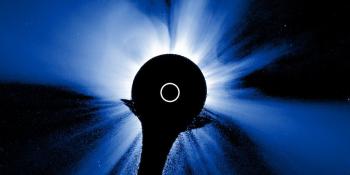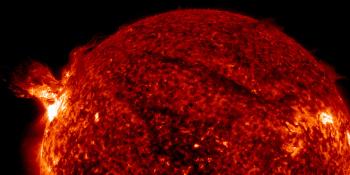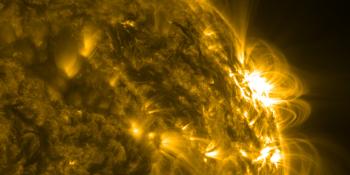Daily bulletin on solar and geomagnetic activity from the SIDC
Emès: 2025 Dec 14 1231 UTC
SIDC Forecast
Erupcions solars
C-class flares expected, (probability >=50%)
Geomagnetism
Active conditions expected (A>=20 or K=4)
Protons solars
Quiet
| 10cm flux | Ap | |
|---|---|---|
| 14 Dec 2025 | 117 | 019 |
| 15 Dec 2025 | 114 | 011 |
| 16 Dec 2025 | 111 | 008 |
Solar Active Regions and flaring
Solar flaring activity was low over the past 24 hours, with only C-class flares. The strongest flare was a C2.8 flare (SIDC Flare 6419) peaking at 13:04 UTC on December 13. It was associated with SIDC Sunspot Group 718 (NOAA Active Region 4304, magnetic type beta). There are currently four numbered active regions on the solar disk. The most complex one is SIDC Sunspot Group 722 (NOAA Active Region 4307) with magnetic type beta-gamma. SIDC Sunspot Group 712 (NOAA Active Region 4296) has rotated across the west limb. SIDC Sunspot Group 724 has decayed into a plage. The solar flaring activity is expected to be low over the next 24 hours, with C-class flares very likely and a chance for M-class flares.
Expulsions de masses coronals
No Earth-directed Coronal Mass Ejections (CMEs) were observed in the available coronagraph imagery in the last 24 hours.
Vent solar
Over the past 24 hours, solar wind parameters (ACE) were enhanced, most likely due to the influence of the high-speed stream from the negative polarity coronal hole (SIDC Coronal Hole 142). Speed values ranged between 480 km/s and 690 km/s. The interplanetary magnetic field values varied between 2 nT and 14 nT. The Bz component varied between -5 nT and 10 nT. The interplanetary magnetic field angle was mostly in the negative sector. Enhanced solar wind conditions are expected to persist over the next 24 hours due to the continued influence of the high-speed stream.
Geomagnetism
Geomagnetic conditions globally were mostly at quiet to unsettled levels (NOAA Kp 2 to 3). Locally, geomagnetic conditions were mostly at quiet to unsettled levels (K BEL 2 to 3), with an interval of active conditions (K BEL 4) between 19:00 UTC and 21:00 UTC on December 13. Mostly quiet to unsettled conditions are expected globally and locally over the next 24 hours, with possible isolated active conditions (NOAA Kp 4, K BEL 4), due to the continued influence of the high-speed stream.
Proton flux levels
The greater than 10 MeV proton flux was below the 10 pfu threshold level over the past 24 hours. It is expected to remain below the threshold level over the next 24 hours.
Electron fluxes at geostationary orbit
The greater than 2 MeV electron flux measured by GOES 18 and GOES 19 was below the 1000 pfu threshold in the last 24 hours. The greater than 2 MeV electron flux is expected to be below the 1000 pfu threshold over the next 24 hours. The 24-hour electron fluence is presently at normal levels and is expected to remain so over the next 24 hours.
Today's estimated international sunspot number (ISN): 075, based on 06 stations.Solar indices for 13 Dec 2025
| Wolf number Catania | /// |
| 10cm solar flux | 122 |
| AK Chambon La Forêt | 021 |
| AK Wingst | 018 |
| Estimated Ap | 017 |
| Estimated international sunspot number | 084 - Based on 15 stations |
Noticeable events summary
| Day | Begin | Max | Final | Loc | Strength | OP | 10cm | Catania/NOAA | Radio burst types | |
|---|---|---|---|---|---|---|---|---|---|---|
| Cap | ||||||||||
Provided by the Solar Influences Data analysis Center© - SIDC - Processed by SpaceWeatherLive
Últimes notícies
Últims missatges del fòrum
Dona suport a SpaceWeatherLive.com!
A lot of people come to SpaceWeatherLive to follow the Solar activity or if there is a chance to see the aurora, but with more traffic comes higher costs to keep the servers online. If you like SpaceWeatherLive and want to support the project you can choose a subscription for an ad-free site or consider a donation. With your help we can keep SpaceWeatherLive online!
Fets del temps al espai
| Última Flamarada-X | 2025/12/08 | X1.1 |
| Última Flamarada-M | 2025/12/12 | M1.1 |
| Última tempesta geomagnètica | 2025/12/12 | Kp5 (G1) |
| Dies sense taques | |
|---|---|
| Últim dia sense taques | 2022/06/08 |
| Número mensual mitjà de taques solars | |
|---|---|
| de novembre 2025 | 91.8 -22.8 |
| de desembre 2025 | 139.6 +47.8 |
| Last 30 days | 106.8 +8.5 |





